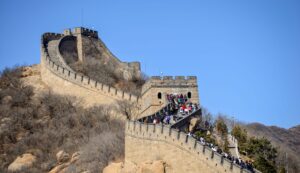The Great Wall of China is a series of fortifications made of stone, brick, tamped earth, wood, and other materials, usually built in an east-to-west line across China’s historic northern borders to defend against Chinese states and empires. Raids and Invasions of Various Nomadic Groups in the Eurasian Steppe. Spanning more than 13,000 miles, the wall is the longest man-made structure in the world. It was in B.C. Built, rebuilt and maintained between the 5th and 16th centuries AD. The Great Wall is a UNESCO World Heritage Site.
The Great Wall of China is not a single continuous wall, but is made up of many walls and fortifications built by different Chinese dynasties over the centuries. The most well-known and best-preserved section of the wall is the Ming Dynasty section, which stretches over 13,000 miles and is the section that most tourists visit.
Construction of the Great Wall began during the 7th century BC, with the walls built by the various states that existed at the time. The first emperor of China, Qin Shi Huang, ordered the walls to be joined together to form a unified barrier during his reign in the 3rd century BC.
Over the centuries, the Great Wall was rebuilt and maintained by subsequent dynasties, with the Ming Dynasty (1368–1644) making the most significant additions and renovations. The Ming-era walls were built of brick and stone, and were up to 30 feet high and 25 feet wide at the base. They featured watchtowers, barracks, and fortifications at strategic locations.
The Great Wall served as a military defense barrier for centuries, but its effectiveness as a barrier has been called into question. However, it served as a psychological barrier that helped to maintain the Chinese people’s sense of security. The Great Wall is also an important symbol of Chinese civilization and a popular tourist destination, attracting millions of visitors each year.
The Great Wall of China is not only the world’s longest wall but also one of the most impressive architectural feats in history. Its construction required the labor of millions of people over many centuries and it had been an important strategic barrier for the Chinese empire throughout the centuries. It is considered one of the New Seven Wonders of the World.
The Great Wall of China is not only a significant architectural and engineering achievement, but also holds great cultural and historical significance. The wall has played a crucial role in shaping Chinese history and culture, and its construction required the labor of millions of people over many centuries. The Great Wall is not only the world’s longest wall but also one of the most impressive architectural feats in history.
The Great Wall of China also holds great strategic significance. The wall served as a military defense barrier for centuries, protecting the Chinese empire from invasions from the northern nomadic tribes. The wall was also used as a means of border control, with the Chinese empire using it to regulate trade and control immigration. The wall was also used as a communication route, with watchtowers and signal towers built along the wall to enable the transmission of information.
Despite its significant role in Chinese history and culture, the Great Wall of China is now facing several threats. The wall has been damaged and destroyed by natural elements such as erosion, weathering, and earthquakes, as well as by human activities such as looting and vandalism. Additionally, the wall is being affected by increased tourism, with the heavy foot traffic causing further damage.
The Chinese government has taken several steps to protect and preserve the Great Wall, including the establishment of the Great Wall of China Society, the creation of a Great Wall protection law, and the launch of several conservation and restoration projects. UNESCO has also designated the Great Wall of China as a World Heritage Site, recognizing its outstanding universal value.
The Great Wall of China is not only a significant architectural and engineering achievement, but also holds great cultural and historical significance. It is a symbol of Chinese civilization and it’s definitely worth visiting, it is a must see site for tourists visiting China.
The Great Wall of China is also an important symbol of Chinese civilization and a popular tourist destination, attracting millions of visitors each year. Some of the most popular sections of the Great Wall for tourists include the Badaling section, the Juyongguan section, the Simatai section, and the Mutianyu section.


Badaling is the most popular section of the Great Wall for tourists as it is the closest to Beijing and it is the most accessible. The Juyongguan section is also popular because it is relatively close to Beijing and it is less crowded than the Badaling section. The Simatai section is popular because it is a remote and less-visited section of the Great Wall, offering a more authentic and less-crowded experience. The Mutianyu section is popular because it offers beautiful views of the surrounding countryside, and it is also less crowded than other sections of the Great Wall.
Tourists visiting the Great Wall of China can choose to hike or take a cable car to the top. The hike can be challenging and strenuous, but it is a great way to experience the history and culture of the Great Wall. The cable car is a more comfortable and less strenuous way to reach the top, but it does not offer the same experience as hiking.
In addition to visiting the Great Wall, tourists can also learn about the history and culture of the Great Wall by visiting the Great Wall Museum, which is located near the Badaling section of the Great Wall. The museum features exhibits on the history and construction of the Great Wall, as well as artifacts and relics from different dynasties.
The Great Wall of China is a must-see destination for anyone visiting China, it is not only a significant architectural and engineering achievement but also holds great cultural and historical significance.
The Great Wall of China is also an important site for researchers and academics. The wall has been the subject of numerous studies on history, archaeology, architecture, engineering, and conservation. Researchers have used various methods such as historical records, field surveys, and remote sensing to study the Great Wall. They have also used scientific methods such as carbon dating and dendrochronology to determine the age of the wall and its various components.
Researchers have also studied the impact of human activities and natural processes on the Great Wall. They have investigated the effects of erosion, weathering, and earthquakes on the wall, as well as the impact of looting, vandalism, and tourism. These studies have helped to inform conservation and restoration efforts for the Great Wall.
The Great Wall of China is also an important site for cultural and educational activities. The wall serves as a venue for cultural events such as performances, festivals, and exhibitions. It is also used as a site for educational activities such as guided tours and workshops. These activities help to promote awareness and understanding of the Great Wall, as well as to generate revenue for conservation and restoration efforts.
The Great Wall of China is a unique and fascinating cultural heritage site that has captured the imagination of people all over the world for centuries. It is an iconic symbol of Chinese civilization and a testament to human ingenuity and perseverance. The Great Wall is an example of the importance of cultural heritage preservation, and it continues to be a source of inspiration for people all over the world.



